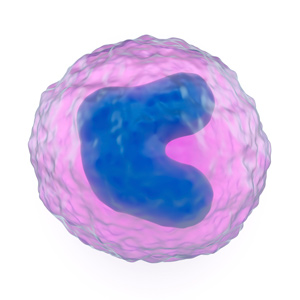
Human dermal CD14+ cells are a class of macrophages derived from blood monocytes.
© somersault18:24/iStock/Thinkstock
Dendritic cells and macrophages are immune cells that orchestrate diverse immune functions within many body tissues, including the skin. New work by A*STAR researchers and colleagues shows that CD14+ cells in the skin — long classified as dendritic cells — are actually macrophages derived from blood monocytes which means they operate differently within the human immune system.
Dendritic cells and macrophages are broadly similar: both take up antigens and present them to immune cells, called T lymphocytes, which drive immune defenses within the body. However, dendritic cells and macrophages orchestrate different immune functions and target different T lymphocyte types. For example, skin dendritic cells that take up antigens migrate to the lymph nodes and present the antigen to so-called naive T lymphocytes that have not been previously exposed to other antigens. But skin macrophages, which are derived from blood monocytes, present antigen to so-called memory T lymphocytes within the skin that are already tuned to respond to one particular antigen.
Immunologists had initially identified CD14+ cells within the skin as dendritic cells. This was partially due to their ability to migrate out of chunks of skin that are placed in a cell culture dish. However, CD14+ cells are only weakly able to stimulate naive T lymphocytes, calling into question their classification as dendritic cells, since activation of naive T lymphocytes is a key characteristic of dendritic cells. In addition, recent gene expression analyses by Florent Ginhoux and Naomi McGovern from A*STAR’s Singapore Immunology Network and colleagues demonstrated that CD14+ cells express many of the same genes as monocytes within the blood, which suggested that skin CD14+ cells may actually be monocyte-derived macrophages.
The researchers therefore examined what would happen to CD14+ cells in skin in humans whose blood monocytes were being ablated as preparation for a hematopoietic stem cell transplant. They found that as monocytes were depleted in the blood, CD14+ cells in the skin were lost. During the recovery period, monocyte numbers in the blood rebounded, followed by a restoration of CD14+ cells in the skin. These findings suggest that, in humans, CD14+ cells in the skin are derived from monocytes.
The researchers found further evidence that skin CD14+ cells better stimulate memory T lymphocytes than naive T lymphocytes, indicating that CD14+ cells behave more like macrophages than dendritic cells.
“Understanding the biology of monocyte-derived cells within human skin will aid in development of new therapies for inflammatory skin conditions, including psoriasis and eczema,” says Ginhoux.
The A*STAR-affiliated researchers contributing to this research are from the Singapore Immunology Network.




